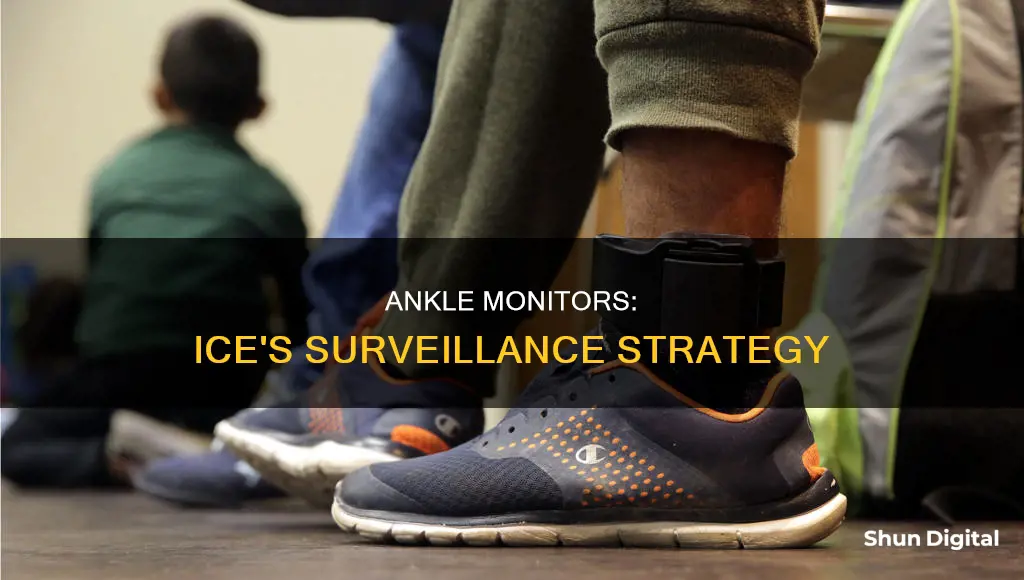
Immigration and Customs Enforcement (ICE) has been issuing thousands of ankle monitors to immigrants, which they call grilletes or electronic shackles. These devices are used to monitor people on probation or house arrest and track their movements using GPS. While ICE claims that ankle monitors ensure immigrants show up for their immigration court proceedings, there are concerns about their effectiveness and ethical implications. Some immigrants report experiencing physical pain, discomfort, and anxiety due to the devices, and they face social stigma and limited employment opportunities as a result of wearing them. Additionally, there are privacy concerns about the data collected by these monitors.
| Characteristics | Values |
|---|---|
| Name of Program | Alternatives to Detention (ATD) |
| Name of Primary Program | Intensive Supervision Appearance Program (ISAP) |
| Alternative Names | Electronic shackles, grilletes |
| Weight | 5.5-ounce (155-gram) |
| Purpose | To ensure immigrants show up to immigration court |
| Effectiveness | 90% success rates in ensuring immigrants show up to immigration court |
| Cost | $4.50 per day |
| Number of Immigrants Supervised | 124,000+ as of September 13, 2024 |
| Physical Effects | Inflammation, severe cramps, bleeding, sores, numbness, bruising, skin eruptions, hair loss, headaches, chest pain, difficulty breathing, overheating |
| Psychological Effects | Anxiety, sleeplessness, depression, social isolation, suicidal thoughts |
| Social Effects | Stigma, loss of job or difficulty obtaining work |
| Privacy Concerns | Lack of transparency about data usage and storage |
What You'll Learn

The Intensive Supervision Appearance Program (ISAP)
ISAP was launched in 2004 as a "humane" alternative to detention for immigrants awaiting their court dates. The program is run by Immigration and Customs Enforcement (ICE) officers, who select participants and supervise them using methods such as ankle bracelets, telephonic reporting, GPS tracking, and unannounced home visits. As of January 2022, at least 182,607 people were enrolled in ISAP, making it the largest supervision program of any US law enforcement agency.
The goal of ISAP is to allow immigrants to live with their families and continue working while their deportation proceedings are pending, as these tend to be lengthy and often last for years. ISAP is also a more cost-effective alternative to detention, with ICE spending over $200 per day to detain someone in immigration detention, compared to as little as $4.50 per day for ISAP.
However, there have been concerns raised about the negative impacts of ISAP on participants, including physical and psychological effects from wearing ankle monitors, social stigma, and limitations on employment opportunities. There have also been reports of inconsistent decision-making processes and a lack of transparency regarding the use of data collected through electronic monitoring.
Removing Sound Bars from Monitors: A Step-by-Step Guide
You may want to see also

Electronic shackles cause physical harm
Electronic shackles, or ankle monitors, have been reported to cause physical harm to those forced to wear them. In a report by Freedom for Immigrants, the Immigrant Defense Project, and the Benjamin N. Cardozo School of Law, one in five surveyed individuals reported receiving electric shocks from the shackles. Other reported effects include aches, pains, cramps, excessive heat, numbness, inflammation, scarring, cuts, and bleeding.
The physical pain and discomfort caused by the shackles are not the only issues. The devices must be charged for hours at least twice a day, with the charger attached to the wearer's body. This restricts the wearer's movement, requiring them to remain close to a power source for extended periods. The frequent charging also interrupts daily life, with one woman reporting that the device beeped throughout the night, causing her to lose sleep.
The weight and bulkiness of the monitors can also make it difficult to walk and carry out daily activities. One woman reported that the belt of the monitor was so tight and heavy that it caused bleeding. The devices can also overheat, burning the skin underneath.
The physical harm caused by electronic shackles is not limited to those described above. In 2016, a woman filed a complaint after experiencing electric shocks, bruising, skin eruptions, hair loss, headaches, chest pain, and difficulty breathing after being fitted with an ankle monitor. The negative health impacts of these devices are severe and far-reaching, causing immense discomfort and pain to those subjected to them.
Finding Monitor Information in the Windows Registry
You may want to see also

Alternatives to Detention (ATD) programs
ATDs are more cost-effective than detention. Immigration and Customs Enforcement (ICE) spends over $200 per day to detain someone in immigration detention, and this number rises to $319 per person per day when detaining families. In contrast, low-cost ATD programs like community supervision or electronic monitoring programs can cost as little as $4.50 per day.
ATDs are also effective at ensuring immigrants show up to immigration court. Many programs exceed 90% success rates, and the Intensive Supervision Appearance Program (ISAP), ICE's primary ATD program, has an absconder rate of only 5%.
However, critics argue that ATDs are not true alternatives to detention, as an increase in enrollment in ATDs has not corresponded with a decrease in detention numbers. Additionally, ATDs have been criticized for their negative impacts on those wearing them, such as causing inflammation, severe cramps, bleeding, sores, and numbness, as well as damaging psychological effects.
ATDs can also cause social stigma, limiting employment opportunities for immigrants. The identification of ankle monitors with criminality makes electronically monitored employees less appealing to employers, even when the employee has no criminal record.
Despite these concerns, the use of ATDs continues to grow. In 2022, over 320,000 people were enrolled in ISAP, up from 200 in 2004. The daily cost per ATD participant is less than $8 per day, making it a cost-effective alternative to detention for ICE.
Understanding Campaign Monitor's Suppression List Removal Process
You may want to see also

The social stigma of wearing an ankle monitor
Ankle monitors, used as alternatives to incarceration, are often bulky and difficult to conceal. Their design has not changed significantly since the 1980s, suggesting that the stigma of wearing them and the difficulty of hiding them could be intended as part of the punishment. Those who wear ankle monitors often feel that they are being stigmatised and are presumed to be dangerous criminals. This perception can lead to social isolation and limit employment opportunities, as potential employers may be deterred by the association of ankle monitors with criminality.
Immigrants, in particular, face challenges due to the stigma associated with ankle monitors. They may experience feelings of imprisonment and shame, as illustrated by a woman's statement: "When you go out into the street, the whole world stops to look at your feet... My son asked me why they put this on me, he said that they only do this to thieves." The stigma can hinder their ability to integrate into society and find employment, impacting their ability to provide for themselves and their families.
The negative perception of ankle monitors can also affect the mental health and well-being of those who wear them. Individuals have reported experiencing anxiety, sleeplessness, depression, and social isolation due to the constant surveillance and restrictions imposed by ankle monitors. The stigma can lead to stress and exacerbate existing mental health issues, making it difficult for individuals to rebuild their lives and reconnect with their communities.
Additionally, ankle monitors can create a sense of distrust and suspicion within communities. The presence of an ankle monitor may prompt members of the public to make assumptions about an individual's character and past actions, potentially leading to social rejection and isolation. This dynamic further contributes to the stigma and challenges faced by those who are monitored.
To mitigate the social stigma associated with ankle monitors, it is important to address the underlying issues of privacy and data protection. The data collected by these devices raises concerns about the potential for government overreach and the invasion of personal privacy. Without proper regulations and transparency, the information gathered through ankle monitors can be misused or sold, further compromising the rights and opportunities of those who wear them.
Straight Talk: Quick Monitor Alignment Check
You may want to see also

The Biden administration's expansion of ISAP
The Biden administration has been criticised for its expansion of the Intensive Supervision Appearance Program (ISAP), which has been described as punitive and ineffective. ISAP is a surveillance program that was introduced in 2004 as a "humane" alternative to detention for immigrants awaiting their court cases. However, the program has been criticised for its use of electronic monitoring devices, such as ankle monitors, which have been reported to cause physical and psychological harm to those who wear them.
In response to concerns about the program, a group of Democratic lawmakers led by Congresswoman Rashida Tlaib sent a letter to the head of the Department of Homeland Security, Alejandro Mayorkas, demanding urgent changes to ISAP. The letter states that between 2006 and 2021, ISAP's budget increased from $28 million to $475 million, while the detention budget increased from $1 billion to $2.8 billion. The lawmakers argue that ISAP has failed to accomplish its stated purpose of reducing the number of immigrants in detention and has instead subjected immigrants to years of surveillance.
Despite these criticisms, the Biden administration has plans to expand the number of people enrolled in ISAP and test the addition of a new, stricter level of surveillance that would require immigrants in the program to stay at home for 12 hours a day. This expansion of ISAP is part of the Biden administration's efforts to manage the influx of immigrants from Central America and find alternatives to family detention. However, critics argue that the use of electronic monitoring devices is not a humane alternative to detention and that the program has not led to a decrease in ICE's incarceration rates.
The expansion of ISAP is just one aspect of the Biden administration's approach to immigration, which also includes efforts to increase border security, address the root causes of migration, and expand lawful pathways to the United States.
Blind Spot Monitoring: Which Toyota Models Have This Feature?
You may want to see also
Frequently asked questions
ICE-issued ankle monitors are used to track the location and movement of immigrants in real time. The monitors are equipped with GPS capabilities and are meant to ensure that individuals waiting for immigration court proceedings are supervised by immigration authorities.
Wearers of ankle monitors have reported various negative physical and psychological effects, including inflammation, severe cramps, bleeding, sores, and numbness around the foot and leg. The devices have also been associated with feelings of imprisonment and social stigma, limiting employment opportunities for immigrants.
The Intensive Supervision Appearance Program (ISAP) is a U.S. government program launched in 2004 as an alternative to detention for immigrants awaiting their court hearings. The program uses electronic surveillance tools such as ankle monitors, voice recognition, or a proprietary tracking app to monitor participants' whereabouts.
There are concerns about the physical and psychological harm caused by the ankle monitors, with reports of pain, discomfort, and electric shocks. The devices have also been criticised for their impact on the wearers' freedom of movement and privacy. Additionally, advocates argue that the use of ankle monitors for immigrants seeking asylum is inappropriate and inhumane.







